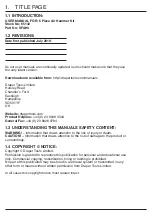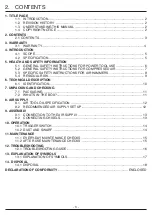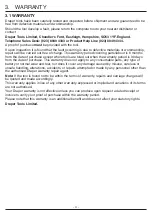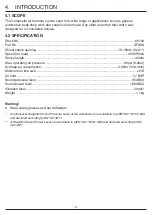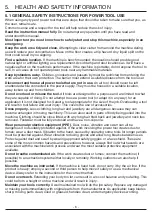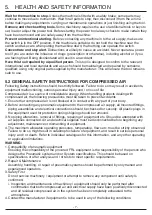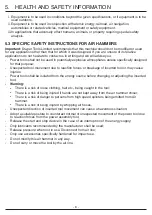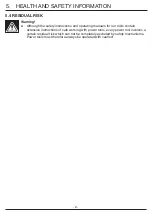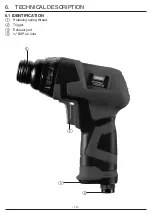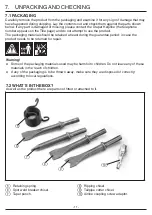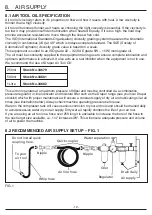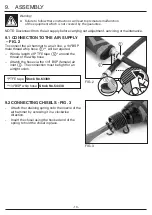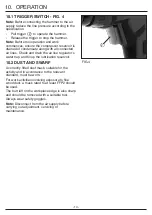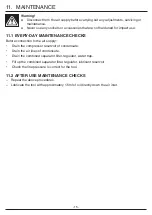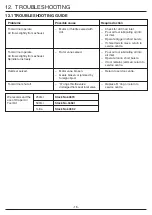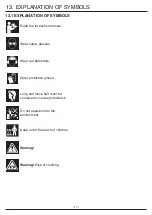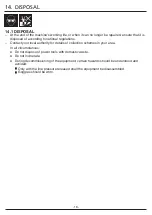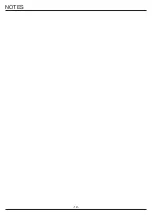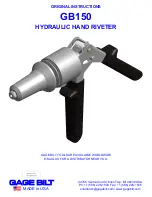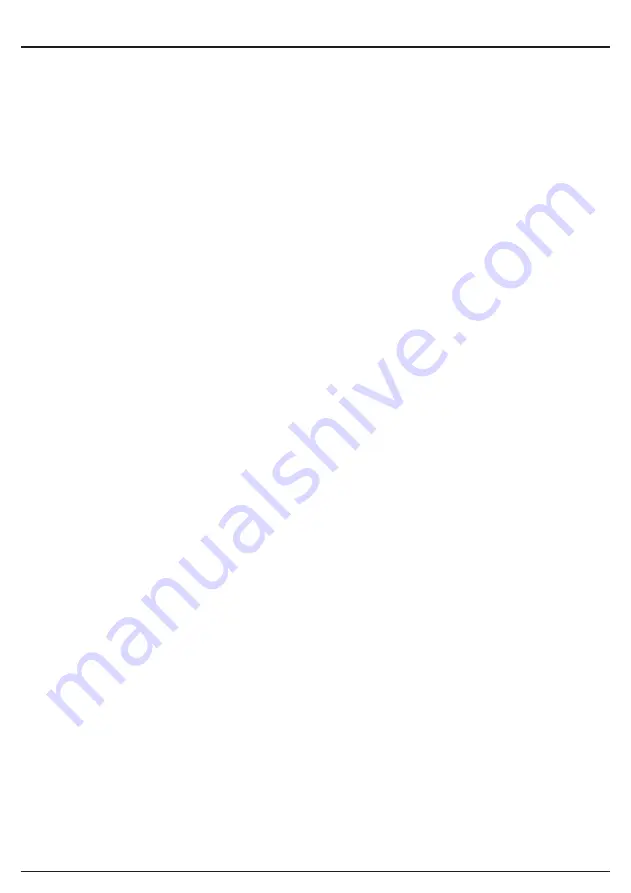
5. HEALTH AND SAFETY INFORMATION
Wait for the machine to stop.
Unless the machine is fitted with a safety brake; some parts may
continue to move due to momentum. Wait for all parts to stop; then disconnect it from the air line
before making any adjustments, carrying out maintenance operations or just finishing using the tool.
Remove and check setting tools.
Some machinery requires the use of additional tools or keys to
set, load or adjust the power tool. Before starting the power tool always check to make certain they
have been removed and are safely away from the machine.
Prevent unintentional starting.
Before connecting any machine in to the air supply, make sure
the switch is in the OFF position. If the machine is portable; do not hold the machine near the
switch and take care when putting the machine down; that nothing can operate the switch.
Concentrate and stay alert.
Distractions are likely to cause an accident. Never operate a power
tool if you are under the influence of drugs (prescription or otherwise), including alcohol or if you
are feeling tired. Being disorientated will result in an accident.
Have this tool repaired by a qualified person.
This tool is designed to confirm to the relevant
international and local standards and as such should be maintained and repaired by someone
qualified; using only original parts supplied by the manufacturer: This will ensure the tool remains
safe to use.
5.2 GENERAL SAFETY INSTRUCTIONS FOR COMPRESSED AIR
Following Safety instructions should be strictly followed. Failure to do so may result in accidents,
equipment malfunctioning, serious personal Injury and / or loss of life.
Compressed air is a source of considerable energy. When handling products dealing with
compressed air, the following precautions must be taken to prevent accidents.
1. Ensure that compressed air is not blocked or in contact with any part of your body.
2. Before connecting any pneumatic equipment to the compressed air supply, all mounted fittings,
piping assemblies and electrical connections should be checked for security. All plastic plugs in
the equipment used for protection during shipping should be removed.
3. No piping alterations, removal of fittings, repairing of equipment etc. Should be attempted with
air supplies connected. Air and electrical supplies must be disconnected before beginning any
adjustment, maintenance or dismantling of equipment.
4. The maximum allowable operating pressures, temperature, flows etc. must be strictly observed.
Failure to do so might result in catastrophic failure of equipment, and result in serious personal
injury and / or death. Refer to individual catalogues for this information, and any other operating
or application limitations.
WARNING:
1. Compatibility of pneumatic equipment
Ensuring the compatibility of the procured FRL equipment is the responsibility of the person who
designs the Pneumatic system and/ or System specifications. This should be based on
specifications or after analysis and / or tests to meet specific requirements.
2. Repair & Maintenance
Assembly, handling, or repair of pneumatic systems should be performed by only trained and
experienced operators.
3. Safety First
Do not service machinery / equipment or attempt to remove any component until safety Is
confirmed.
i. Inspection and maintenance of machinery / equipment should only be performed after
confirmation that both compressed air and electrical supply have been positively disconnected
and all residual compressed air in the system has been completely exhausted to the
atmosphere.
4. Contact the manufacturer if equipment is to be used in any of the following conditions:
10. OPERATION
(2)
FIG.4
10.1 TRIGGER SWITCH - FIG. 4
Note: Before connecting the hammer to the air
supply reduce the line pressure according to the
specification.
- Pull trigger
(2)
to operate the hammer.
- Release the trigger to stop the hammer.
Note: Before tool operation and work
commences, ensure the compressor reservoir is
drained of condensate along with all connected
air lines. Check and drain the air line regulator’s
water trap and fill up the lubrication reservoir.
10.2 DUST AND SWARF
A correctly fitted dust mask, suitable for the
activity and in accordance to the relevant
standard, must be worn.
For work activities involving exposure to fine
wood dust, a mask rated to at least FFP2 should
be used.
The burr left on the workpiece edge is also sharp
and should be removed with a suitable tool.
Always wear safety goggles.
Note: Disconnect from the air supply before
carrying out adjustment, servicing or
maintenance.
- 7 -
- 14 -
5. HEALTH AND SAFETY INFORMATION
5.1 GENERAL SAFETY INSTRUCTIONS FOR POWER TOOL USE
When using any type of power tool there are steps that should be taken to make sure that you, as
the user, remain safe.
Common sense and a respect for the tool will help reduce the risk of injury.
Read the instruction manual fully.
Do not attempt any operation until you have read and
understood this manual.
Most important you must know how to safely start and stop this machine, especially in an
emergency.
Keep the work area tidy and clean.
Attempting to clear clutter from around the machine during
use will reduce your concentration. Mess on the floor creates a trip hazard. Any liquid spilt on the
floor could result in you slipping.
Find a suitable location.
If the machine is bench mounted; the location should provide good
natural light or artificial lighting as a replacement. Avoid damp and dust locations as it will have a
negative effect on the machine’s performance. If the machine is portable; do not expose the tool to
rain. In all cases do not operate power tools near any flammable materials.
Keep bystanders away.
Children, onlookers and passers by must be restricted from entering the
work area for their own protection. The barrier must extend a suitable distance from the tool user.
Disconnect and house all power tools that are not in use.
An air tool should never be left
unattended while connected to the power supply. They must be housed in a suitable location,
away locked up and from children.
Do not overload or misuse the tool.
All tools are designed for a purpose and are limited to what
they are capable of doing. Do not attempt to use a power tool (or adapt it in any way) for an
application it is not designed for. Select a tool appropriate for the size of the job. Overloading a tool
will result in tool failure and user injury: This covers the use of accessories.
Dress properly.
Loose clothing, long hair and jewellery are all dangerous because they can
become entangled in moving machinery: This can also result in parts of body being pulled into the
machine. Clothing should be close fitted, with any long hair tired back and jewellery and neck ties
removed. Footwear must be fully enclosed and have a non-slip sole.
Wear personal protective equipment (PPE).
Dust, noise, vibration and swarf can all be
dangerous if not suitably protected against. If the work involving the power tool creates dust or
fumes; wear a dust mask. Vibration to the hand, caused by operating some tools for longer periods
must be protected against. Wear vibration reducing gloves and allow long breaks between uses.
Protect against dust and swarf by wearing approved safety goggles or a face shield. These are
some of the more common hazards and preventions; however, always find out what hazards are
associated with the machine/work process and wear the most suitable protective equipment
available.
Do not breathe contaminated air.
If the work creates dust or fumes; connect the machine (if
possible) to an extraction system either locally or remotely. Working outdoors can also help if
possible.
Move the machine as instructed.
If the machine is hand held, do not carry it by the air line. If the
product is heavy; employ a second or third person to help move it safely or use a mechanical
device. Always refer to the instructions for the correct method.
Do not overreach.
Extending your body too far can result in a loss of balance and you falling. This
could be from a height or onto a machine and will result in injury.
Maintain your tools correctly.
A well maintained tool will do the job safely. Replace any damaged
or missing parts immediately with original parts from the manufacturer. As applicable; keep blades
sharp; moving parts clean, oiled or greased; handles clean; and emergency devices working.
11. MAINTENANCE
11.1 EVERY-DAY MAINTENANCE CHECKS
Before connection to the air supply:
• Drain the compressor reservoir of condensate.
• Drain the air lines of condensate.
• Drain the combined separator filter, regulator, water trap.
• Fill up the combined separator filter, regulator, lubricant reservoir.
• Check the line pressure is correct for the tool.
11.2 AFTER USE MAINTENANCE CHECKS
– Repeat the above procedures.
– Lubricate the tool with approximately 1.5ml of oil directly down the air inlet.
Warning!
● Disconnect from the air supply before carrying out any adjustments, servicing or
maintenance.
● Never use any sockets or accessories that are not hardened for impact use.
- 6 -
- 15 -
Summary of Contents for STORMFORCE 65142
Page 19: ...NOTES 19 ...


